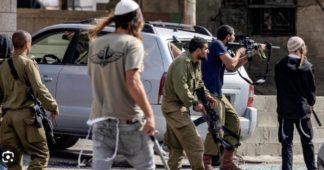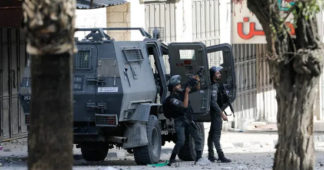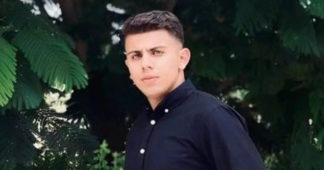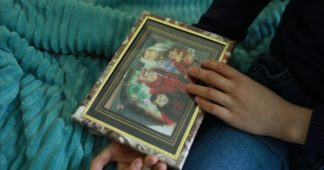By Qassam Muaddi*
Jun 2, 2025
After being forced out of their homes by violent Israeli settlers, the Bedouin community of Maghayer al-Deir joins a growing list of Palestinian Bedouins whose villages have been taken over by settlers since October 7, 2023.
May 22, 2025, was the last day of life as they knew it for the Bedouin community of Maghayer al-Deir, which until recently used to reside east of Ramallah, in the central occupied West Bank. The 24 Palestinian families who made up the community were forced to gather their belongings and leave their home in the eastern slopes of Ramallah overlooking the Jordan Valley. After three days of intense harassment and attacks on the community, Israeli settlers now have complete control over the little valley.
Ahmad (not his real name), a father of 6 children from Maghayer al-Deir who spoke to Mondoweiss on the condition of anonymity, said that he had called the valley home all his life. “I was born in Maghayer al-Deir and have always been there,” he said. “I wouldn’t have traded it for anywhere in the world. God is our witness: we resisted for almost two years and bore what others wouldn’t. But we were left completely alone and had no choice but to leave.”
Since October 7, 2023, Israeli settlers have intensified their attacks on Palestinian rural communities in the West Bank, harassing, attacking, and completely displacing thousands of Palestinians. With each new displaced community, Israeli settlers gain control of more strategic areas for the expansion of established settlements or the establishment of new settler outposts.
According to Hasan Mleihat, spokesperson for the al-Baidar organization for the defense of Bedouin rights in Palestine, Israeli settlers have displaced 62 out of the 212 Bedouin communities in the West Bank since October 2023. These include 12,000 out of the roughly 400,000 West Bank Palestinian Bedouins.
“It is a wholesale ethnic cleansing campaign of exclusively Bedouin communities, which has been happening far away from the media’s attention,” Mleihat told Mondoweiss.
Generations shaped by displacement
Many of these displaced Bedouin communities have now been twice-displaced, since several of them used to live in other parts of historic Palestine before being expelled by Zionist militias in 1948. The Bedouins of Maghayer al-Deir are one of those communities.
For centuries, they have lived in the Naqab desert in the south of Palestine, with clan and tribal ties reaching as far away as southern Jordan and the outskirts of Gaza. In the early 1980s, many of these families, who lived in the eastern slopes of the central West Bank hills, gathered and formed multiple communities.
“The land in Maghayer al-Deir is part of the lands of the village of Deir Dibwan,” Ahmad pointed out, referring to the village that lies east of Ramallah. “It belongs to particular families who allowed us to establish our community there. Since my childhood, I witnessed the development of life in Mughayyir al-Deir; it was always simple and pleasant, although with a lot of hard work. But it changed over the years.”
“At the beginning, we lived in our traditional tents made out of goat or camel hides,” Ahmad continued. “But then, when we began to use trailers, we started owning more tractors and vehicles, and many of our community went to university. We have doctors, engineers, and teachers now.”
“Although we were living in Area C, the civil administration of the [Israeli] occupation army allowed us to multiply our trailers and even build some rooms,” he noted. “They let us open a small medical center in one of the trailers and extend a water pipe from the Israeli highway to the community. That allowed us to buy water from the Israeli company, Mekorot.”
Ahmad said the Israeli occupation had already restricted where structures could be built, but his community was still able to graze livestock across the surrounding hills, past the areas where they were permitted to build. This was their main source of income for most of the year, and they only needed to buy feed for the livestock during the dry months when there was no grass in the summer. “That’s how I grew up,” he said. “But everything changed after October 7.”
Attacks escalate after October 7
The broad Israeli crackdown on West Bank communities after October 7 was complemented by a wave of settler rampages and regular attacks that ravaged West Bank towns and rural areas. Palestinian villages and Bedouin communities in the countryside of Nablus, Ramallah, the Jordan Valley, and southern Hebron have suffered the brunt of these attacks.
In the eastern slopes of Ramallah, the first mass expulsion of a large Bedouin community took place on October 12, when 40 families were expelled in a single day from the community of Wadi Siq.
“The same day that settlers expelled Wadi Siq, they attacked Maghayer al-Deir,” Ahmad explained. “They broke the water pipe and left the community without a water supply. From that day on, the attacks became daily.”
“Two things changed everything for us,” he added. “First, the settlers blocked our access to grazing lands, killing our capacity to live off our livestock, since we were suddenly forced to buy feed for our sheep year-round. Second, the Israeli Civil Administration took sides with the settlers in every case that we brought to the Israeli police or army.”
“Settlers began to roam between the houses on a regular basis, throw rocks, and threaten us. Although they tried to steal sheep, we always managed to push them back, but it wasn’t without cost,” he explained.
“One time, I pushed off a settler who was threatening me in front of my own house, but the Israeli police decided to arrest me and made me pay a 5,000 shekel (~$1,429) fine for defending myself, which they interpreted as me hitting an Israeli youngster, regardless of the fact that he was at my house.”
Piecemeal ethnic cleansing
Maghayer al-Deir has remained removed from media attention throughout the past 19 months of settler escalations in the West Bank, despite the increasing pressure on its inhabitants and the actual expulsion of most Bedouin communities in its vicinity. That was until last week, when Israeli settlers established a new outpost only 20 meters away from the houses of Maghayer al-Deir, ramping up the harassment to an entirely different level.
“Once the settlers established themselves beside us, life became impossible,” Ahmad explained. “They broke into our houses multiple times a day, took photos of children and women inside homes, threatened us with death while pointing their firearms at us, and stole several sheep. We just couldn’t sleep at night or go too far during the day. Eventually, I thought of my children’s safety.”
“Several heads of families, including myself, gathered at one of the homes and discussed what to do, with the settlers standing nearby. When it was my turn to speak, I said that we were completely unprotected, with Israeli authorities completely siding with the settlers and the Palestinian Authority unable to protect us. I said we couldn’t continue to live in these conditions,” he said.
“The majority agreed with me, and that same night, I decided to leave Maghayer al-Deir. It was the most painful decision of my life,” Ahmad concluded.
Palestinian residents of the Maghayer al-Deir Bedouin community pack their belongings as they leave following repeated attacks and harassment by Israeli settlers, May 22. (Photo: Wahaj Bani Moufleh)
The families of Maghayer al-Deir were dispersed across multiple locations. Some relocated to the outskirts of neighboring villages, but the available land to receive more displaced Bedouin families in the area was already limited. Ahmad moved with his own family and seven others to the industrial zone of Beitunia, south of Ramallah. The rural Bedouin tents and sheep barracks add an almost surreal contrast to the polluted industrial and urban landscape.
“There is nowhere to graze here; we are in the city, and not in the best part of it. We’re located between a dumpsite, a factory, and a cemetery,” said Ahmad. “We used to have a life, and it has come to an end. I can’t be a shepherd anymore, and I don’t know how we will live our lives from now on.”
As the displacement of Palestinians in the West Bank continues, the Israeli government announced the approval of 22 new settlements across the territory, exactly one week after residents were forced out of Maghayer al-Deir.
Last Wednesday, Finance Minister Bezalel Smotrich, a key figure in Israel’s annexation efforts in the West Bank, praised the expansion of Israeli control in a speech. “We are being blessed with the opportunity, thank God, of seeing an expansion of the borders of the Land of Israel, on all fronts,” he said. “We are being blessed with the opportunity to blot out the seed of Amalek, a process which is intensifying.”
In service of that goal, Israel is dismantling Palestinian communities like Maghayer al-Deir, piece by piece.
*Qassam Muaddi is the Palestine Staff Writer for Mondoweiss. Follow him on Twitter/X at @QassaMMuaddi.
We remind our readers that publication of articles on our site does not mean that we agree with what is written. Our policy is to publish anything which we consider of interest, so as to assist our readers in forming their opinions. Sometimes we even publish articles with which we totally disagree, since we believe it is important for our readers to be informed on as wide a spectrum of views as possible.











